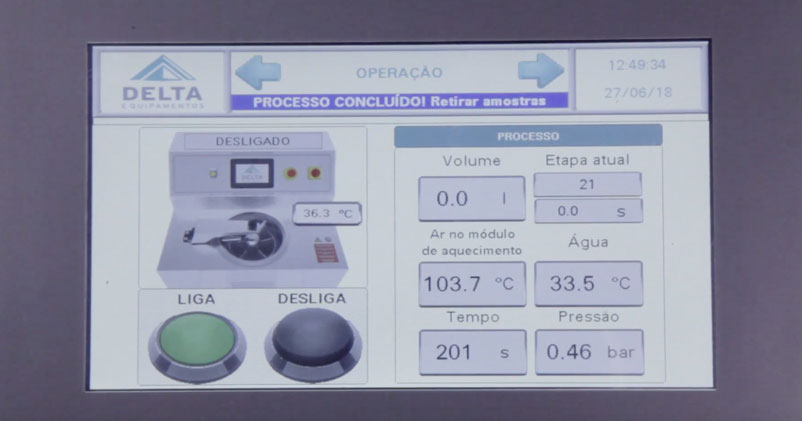Quality control in garment manufacturing is a set of procedures aimed at maintaining the standard, policies, and performance of the entire production process, from management and administration to product delivery. Therefore, it goes beyond just inspecting the pieces.
Modernizing quality control in the textile industry is an essential step for those aiming to stay competitive in the market and achieve positive results, as manual procedures and outdated methods are limited and do not meet the demand or complexity of current processes.
Quality control in garment manufacturing: the importance of modernization
Any business, regardless of the industry, needs to be able to do more with less. . Especially in a scenario where adaptation to the concept of Industry 4.0 is not just a trend but a reality and a business model.
Having this profile means providing special conditions, saving on operations, and passing cost reductions on to customers, thus strengthening your relationship with the market. To achieve results of this magnitude, the entire textile garment manufacturing chain needs to modernize. And the use of technology can be the difference between maintaining operations or closing doors.
Garment manufacturing is affected by all the production imbalances, with this stage bearing the weight of common problems in garment manufacturing from other sectors and phases preceding production. All this lack of control affects the quality of your product, employee productivity, your image in the market, and also contributes to increasing business costs. In other words, your profit is put at risk.
Therefore, companies must invest in efficient management systems to ensure the operation, reliability, agility, cost reduction, and quality control in garment manufacturing across all their processes.
Utilizing technology, regardless of the sector of a company, adds value to its products and, consequently, to its brand. With the right tools, it is possible to streamline processes, reduce costs, and ensure superior quality in textile garment manufacturing operations.
So, here are some important steps to modernize quality control in garment manufacturing.
Technologies empower businesses in quality control in garment manufacturing
Technologies are to textile companies as yeast is to bread. Simply use the right measure and method at each stage of production to achieve excellent results. Modernizing the processes of a garment manufacturing company, for example, speeds up and allows for more effective control of work and also enhances its growth.
Based on these indicators, it is no longer viable for a company to continue to rely on old and faulty equipment or inefficient methods for quality control, as they are prone to errors and increase costs and expenses.
Similarly, it is no longer possible to be competitive in the current environment without an efficient management system.

Technological advancement is impossible to stop and modernizing quality control in clothing is a step towards textile industry 4.0. Those who do not adapt to the times will invariably end up losing more and more competitiveness until they become obsolete.
Currently, management needs to have real-time data on operations at hand, with agility that allows for decision-making and strategy changes before suffering losses. This predictability based on information and numbers is increasingly a watershed between bankruptcy and success.
This further emphasizes the need to invest in technology, especially to modernize quality control in garment manufacturing, and also to train teams involved in receiving inputs.
Furthermore, we cannot overlook a fundamental need for the textile market: diversification. Especially concerning machinery, diversifying your production line with equipment that performs different functions, catering to various fabric models, for example, is essential to offer diversification to your customers.
Therefore, understand how to modernize quality control and the advantages it can provide for textile garment manufacturing.
Modernizing quality control in manufacturing
This is the initial question that needs to be answered. Below, you can see a step-by-step guide to customized solutions especially for companies in the sector, developed by Delta Equipamentos.
Make a diagnosis
Before you go modernizing everything and investing, stop and reflect on your business. Analyze each sector and production stages of your clothing.
List which procedures are outdated. Take the opportunity to compare your performance with the current market scenario.
Understand the problems your industry needs to solve. From there, develop a strategy to solve them with technologies (automation and process optimization).
Set goals and take the necessary actions to modernize quality control in manufacturing, resources, equipment, and everything you foresee as important.
Implement management software
Technology evolves non-stop. One of the benefits is the possibility of customizing management software to meet a company’s needs in a personalized way.
So, bet on systems developed specifically for your production model and gain even more efficiency.
In addition to reducing manual work, management systems can obtain strategic information and data like no other type of tool.
An excellent example of this type of system is theERP – Enterprise Resource Planning or Enterprise Resource Planning.
This technology brings together all relevant data for the company in a single standardized environment.

Having the right information at hand to make decisions is essential. Collecting this data at each stage of the production process is the right way to modernize quality control in clothing or any other stage of the production process.
ERP provides a complete view of performance, problems and opportunities: both to prevent damage and to optimize results, through quality control, for example.
Your reports are more transparent when displaying performance results, as they do not leave out any productive aspect.
Among other benefits, an ERP system allows you to identify which product is having the best return, according to various criteria, depending on how it is structured for your industry.
He can, therefore, compare the product that offers the most positive return according to the public’s habits, stock turnover, last negotiation with the supplier and even the working method of the professional responsible for the service.
ERP is certainly a solution to modernize quality control in manufacturing in numerous sectors.
Between them:
- Purchasing management;
- Stock management;
- Controlling and costs;
- Logistics;
- Sales and billing;
- Human Resources;
- Issuance of invoices.
+Learn more: How to improve the productivity of a clothing factory?
+Learn more: The future of the Textile Industry in Era 4.0: with Robson Wanka
Recreate processes
Starting from the idea that nothing is so good that it cannot be improved, take the opportunity to recreate processes.
The objective is to develop the habit of periodically reviewing your industry’s processes, so that improvements to be made are constantly identified.
This type of procedure is common in companies considered innovative. They seek to identify methods that no longer meet market demands in order to improve them.
+Learn more: Advanced manufacturing in the Textile Industry.
Dedicate energy to empowering your team
Even investing in technologies, your company’s main resource will continue to be human capital. Therefore, training your team and promoting a healthy and safe environment is essential.
There will be no point in investing in technologies, such as management programs and modern equipment, if your team does not know how to operate them to get the best out of them.

So, no matter how much you invest in the best equipment and machines on the market, these devices need trained and qualified people to handle them and monitor their operation.
Therefore, prepare your entire team for changes in the production and work model, educate employees about good quality control practices in manufacturing and make sure that the production line has a good layout, as this affects productivity .
Discover talents among your employees. Proactive employees will act to take advantage of everything that modernizing quality control allows in terms of results.
Invest in efficient and modern machinery
The production and quality control processes in clothing were very different from today’s needs and realities. The market is more demanding, which is why companies are more competitive.
Therefore, manual activities and machines that were used in the past are no longer efficient in the current steps and procedures. New activities and production phases were developed so that the products are increasingly modern and of high quality.
Therefore, the first investment and change in the industry must be aimed at renewing the machines and equipment used. Look for innovations, complete, updated devices that allow for process automation and efficiency.
The clothing sector is quite dynamic and needs to have production capacity to meet the large volume of trends and changes. Fashion, being volatile, requires efficient, fast and agile industries in their processes.
Therefore, investing in good new machinery is the first step towards achieving these objectives, as new equipment and work tools enhance the entire production cycle and guarantee productivity and quality.
+Learn more: What is quality control? How does it work in the textile industry?
+Learn more: Advanced manufacturing: what it is and who is already using it
Steps that deserve attention in quality control in manufacturing
Below, we have separated some steps and processes that must be planned and well-structured as they affect your quality control, as well as some machines that can modernize your production. Check it out.
Receiving merchandise
The first inspection of your company’s merchandise, that is, your raw material, can influence your entire production and the final result of your products, as this must go through well-structured stages of quality control. Understand the reason.

It is at this stage that some samples of mesh rolls received from suppliers are evaluated. Analyzes must consider what was established in the purchasing process and must be included in the technical sheet:
- Grammage;
- Tone;
- Shrinkage;
- Width;
- Weight.
At the end of the process, the fabric may or may not be approved. If so, proceed to the next step. Otherwise, your manufacturer may return it to the supplier for non-compliance.
In negative cases, this can happen due to low quality of the product offered by the supplier, due to carelessness in the storage and transportation process, for example. Among other reasons.
The importance of this step already indicates that it needs to be carried out using equipment that will offer accurate results. To meet this demand from the textile industries, the Sample Washer is essential.
The equipment created by Delta, for example, performs shrinkage tests and analyzes dimensional changes. With this, you can not only evaluate the quality of the raw material and the final product but also of the pieces. This ensures durability and more satisfaction for the consumer, as well as eliminates financial waste with materials prone to damage.
Quality inspection
Here, a broader evaluation of the fabric is made, which includes analysis regarding the quantity of inspected samples. A great alternative is a revision machine capable of performing:
- Qualification;
- Quantification;
- Generation of a defect map, with analysis of the compromise of the fabric’s usable area;
- Physical analysis of quality standards per roll.
All these processes can be done using Delta’s Revision Machine, developed with the purpose of ensuring quality standards in clothing manufacturing and gathering as much information as possible about each fabric roll that arrives at the facility.
Fabric resting
In the midst of technological advancements that favor production agility, some clothing manufacturers still tend to promote conventional fabric resting for their production. These companies wait for 24 to 48 hours for fabric resting.
For this, the rolls are manually opened, and the materials are placed on racks or tables. However, to turn these 24 or 48 hours of waiting into production time, Delta has also created a solution: a Fabric Relaxing Machine, which performs the following processes:
- Relaxation (Knitwear rest);
- Generation of length and width data.
Hive Storage
This type of storage preserves rolls of fabric, keeps your clothing stock organized and also helps to optimize spaces.
They are a solution to do away with traditional storage on racks and shelves.
Dressing and Cutting
The entire process of modernizing quality control in manufacturing mentioned in previous stages of production positively and directly affects the results that will be obtained in this phase.
This will happen because during planning it is determined that a number of pieces will be produced per roll of mesh, which in turn should result in a revenue Y.
The expectation is that in addition to covering the investment in raw materials (rolls of mesh), production will generate an estimated profit of Y or the so-called Return on Investment (ROI).

However, if small problems occur at each stage of the process, the result will be greater expenses and a lower Return on Investment.
For these and other reasons, the entire textile chain cannot fail to modernize quality control in manufacturing. More than a trend, the use of technologies represents survival for any company in the market, as demand is extremely competitive and volatile.
So, if your company is reviewing processes and looking for solutions to modernize production, contact Delta’s service team and find out about alternatives that can facilitate this journey.
Published on: 06/12/2018 and Updated on: 12/18/2019


![E-book]How to ensure quality control in the textile industry?](https://deltamaquinastexteis.com.br/wp-content/uploads/2019/04/ebook-como-garantir-o-controle-de-qualidade-na-industria-textil.jpg)
